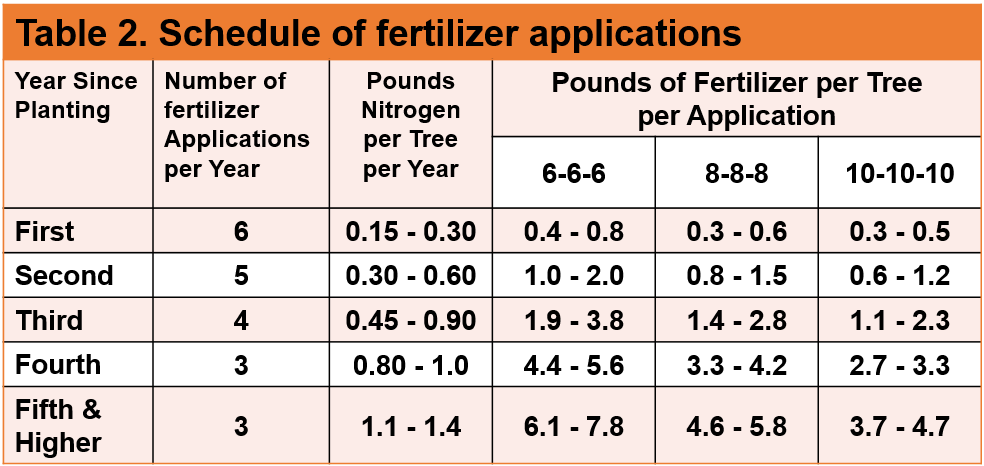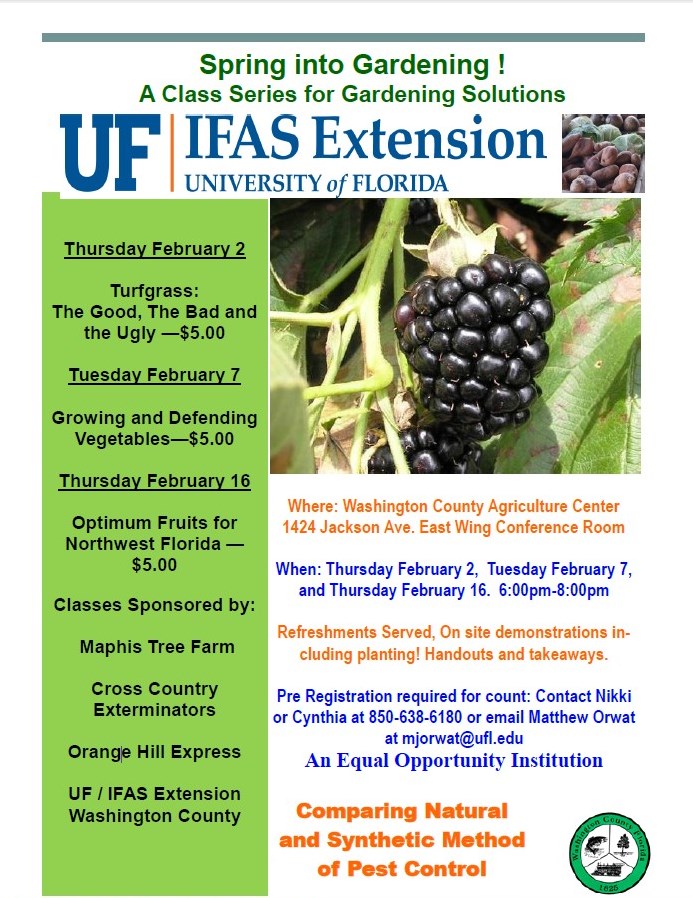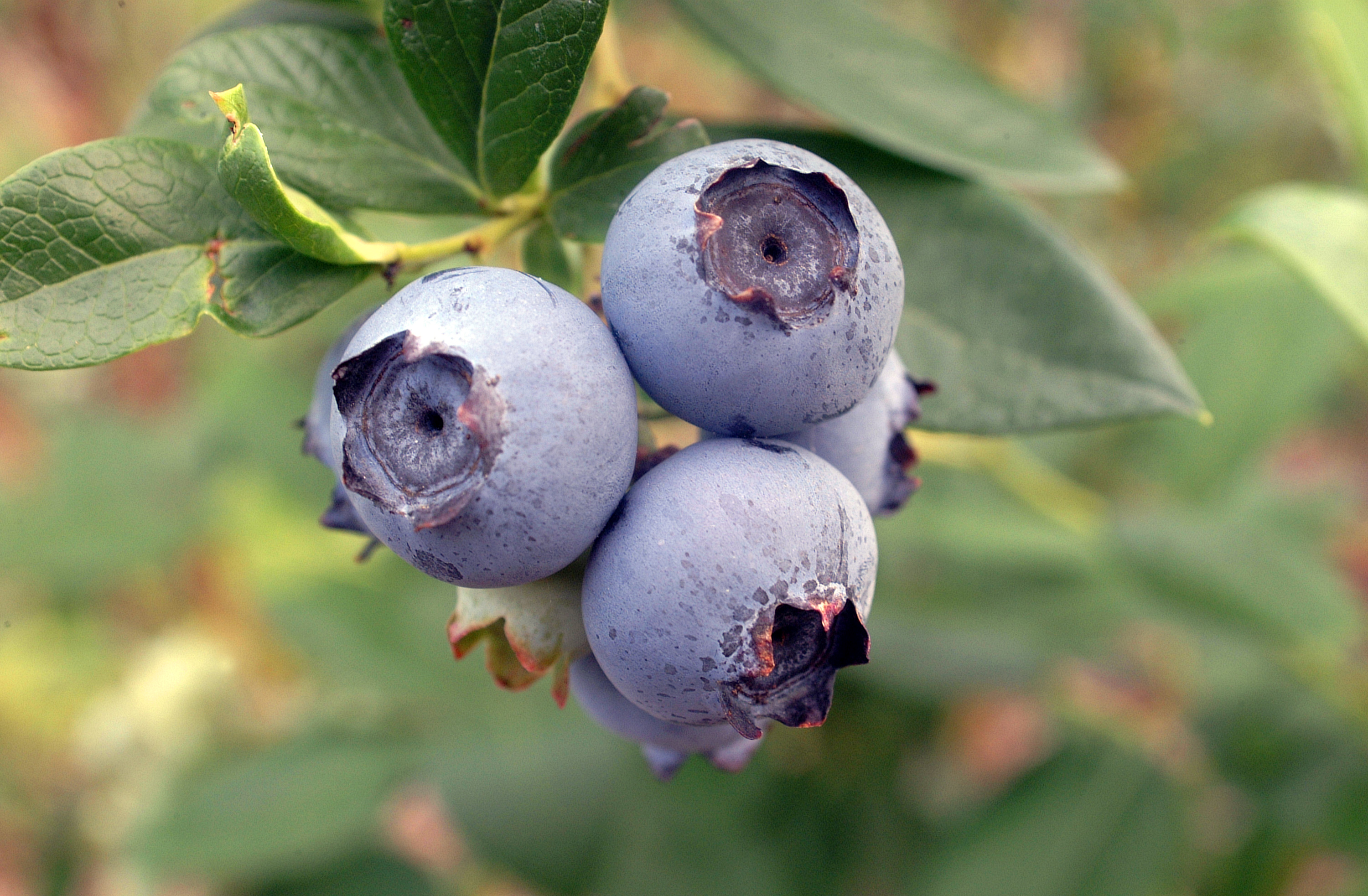
by Carrie Stevenson | May 1, 2017

The Southeastern blueberry bee uses buzz pollination on a blueberry plant. Photo credit: Tyler Jones, UF IFAS.
This time of year, blueberry bushes are flowering and small fruit are coming onto the wild and cultivated bushes in north Florida. Many of us, myself included, look forward to the late-spring harvest of blueberries, taking our children out to u-pick operations and digging out family recipes for blueberry-filled desserts.
What many do not know, however, is that there’s a specialized bee that literally lives for this season. During the last few weeks, this little insect has been furiously pollinating blueberry bushes during its short, single-purpose lifetime.
The Southeastern blueberry bee, Habropoda labriosa is active only in mid-March to April when blueberry plants are in flower. They are smaller than bumblebees, and the yellow patches on their heads can differentiate males. Blueberry pollen is heavy and sticky, so it is not blown by the wind, and the flower anatomy is such that pollen from the male anther will not just fall onto the female stigma. Blueberry bees must instead attach themselves to the flower and rapidly vibrate their flight muscles, shaking the pollen out. Moving to the next flower, the bee’s vibrations will drop pollen from the first flower onto the next one. This phenomenon is called “sonicating” or ‘buzz pollination” and is the most effective method of creating a prolific blueberry crop.
Blueberry bees do not form hives, but create solitary nests in open, sunny, high ground. Females will dig a tunnel with a brood chamber large enough for one larva, filling it with nectar and pollen. After laying an egg, the female seals the chamber and the next generation is ready. The species produces only one generation of adults per year.
By the time we are picking fresh blueberries next month, you probably won’t see any blueberry bees around. However, we should all consider these insects’ short-lived but vitally important role in Florida’s $82 million/year blueberry industry!
For more information, check out the beautifully illustrated USDA Forest Service publication, “Bee Basics—An Introduction to our Native Bees,” or North Carolina State University’s entomology website.

by Ray Bodrey | Mar 20, 2017

Figure 1: Edible Landscaping.
Credit: Dr. Gail Hansen, Environmental Horticulture-UF/IFAS
Edible landscaping has become a trend for many gardening enthusiasts. A combination of edible plants along with traditional ornamentals can create an artful presentation. There are some challenges when designing such a landscape, but in those challenges opportunities’ may be found. One of the most difficult challenges is making sure your garden or landscape is healthy and vibrant year-round since many edibles are short-lived annuals. These include plants such as eggplant, pepper, lettuce, artichoke and some annual herbs. There is a solution to this concern. First, know your edible plant’s propagation and maturity months. This way you can offset plantings to ensure color in your landscape. Another key measure is to mix some evergreen ornamentals in with short season edibles and long season edibles. Examples of long season edibles include berry shrubs, fruit trees and biennial or perennial herbs.
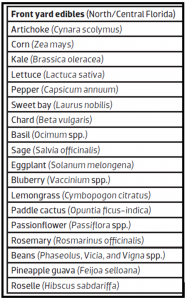
Table 1: North/Central Florida Front Yard Edibles.
Credit: Dr. Gail Hansen, Environmental Horticulture-UF/IFAS.
When designing your edible landscape, think about style and theme to help guide you through the process. A formal design has more straight edges and geometric shapes, whereas the more natural approach has meandering edges and irregular shapes. A color scheme in harmony is very important. Remember, an edible landscape should not just be a production food garden but a visual treat. The goal is not to grow a high yield garden, but only to produce supplemental edibles to make the endeavor worthwhile.
Dr. Gail Hansen, Associate Professor of Environmental Horticulture at the University of Florida, has developed twelve ideas when creating an edible landscape:
- Combine reliable, low-maintenance ornamental with edible plants. Use evergreen ornamentals to maintain enough green structure, so that potential cool season bare spots are not visual.
- Use support structures for an artistic effect and to assist in growth of some plants. Trellises, arbors and even tomato cages are some examples that can be used.
- Use containers in areas to keep the landscape more organized. Planters will also help in maintenance, as plants will be easier to reach and the soil will be easier to manage.
- Create some hard edges in your landscape. Raised beds, garden walls and borders will give defining lines to the landscape and promote a clean appearance.
- A pathway through the landscape will both provide an access to plants and give an inviting appeal. Brick pavers, gravel and mulch are good examples of pathway material.
- Remember color is key. Create a visually pleasing combination of plant color, form, texture and sizes.
- Always start by keeping it simple. So, start small and simple. Then, you can begin filling in the landscape.
- Look for one unique feature to create an added interest to you landscape and provide growth to plants. This could be a shade house for ferns and other hanging baskets or a hay bale, where lettuce, tomatoes or peppers could grow upon.
- Select appealing and easy to grow plants that you want to eat!
- Let plants reach maturity before taking them out of the landscape. For example, rainbow chard will grow larger, if allowed to continue to grow after seed has been produced.
- Use the Florida-Friendly Landscaping principle, “Right Plant, Right Place”, when adding edibles to your landscape. Match the growing needs with the most suitable location.
- Consider your location and layout for irrigation. All plants need some degree of water. An above ground drip irrigation system is usually the most flexible and adjustable irrigation method in regards to overall plant watering needs in a landscape.
Following Dr. Hansen’s ideas will help you create the edible landscape of your dreams. For more information on edible landscaping, please contact your local county extension office for more details.
Supporting information for this article can be found in the UF/IFAS EDIS Publications, “Landscape Design with Edibles” by Dr. Gail Hansen: http://edis.ifas.ufl.edu/pdffiles/EP/EP47500.pdf
UF/IFAS Extension is an Equal Opportunity Institution.
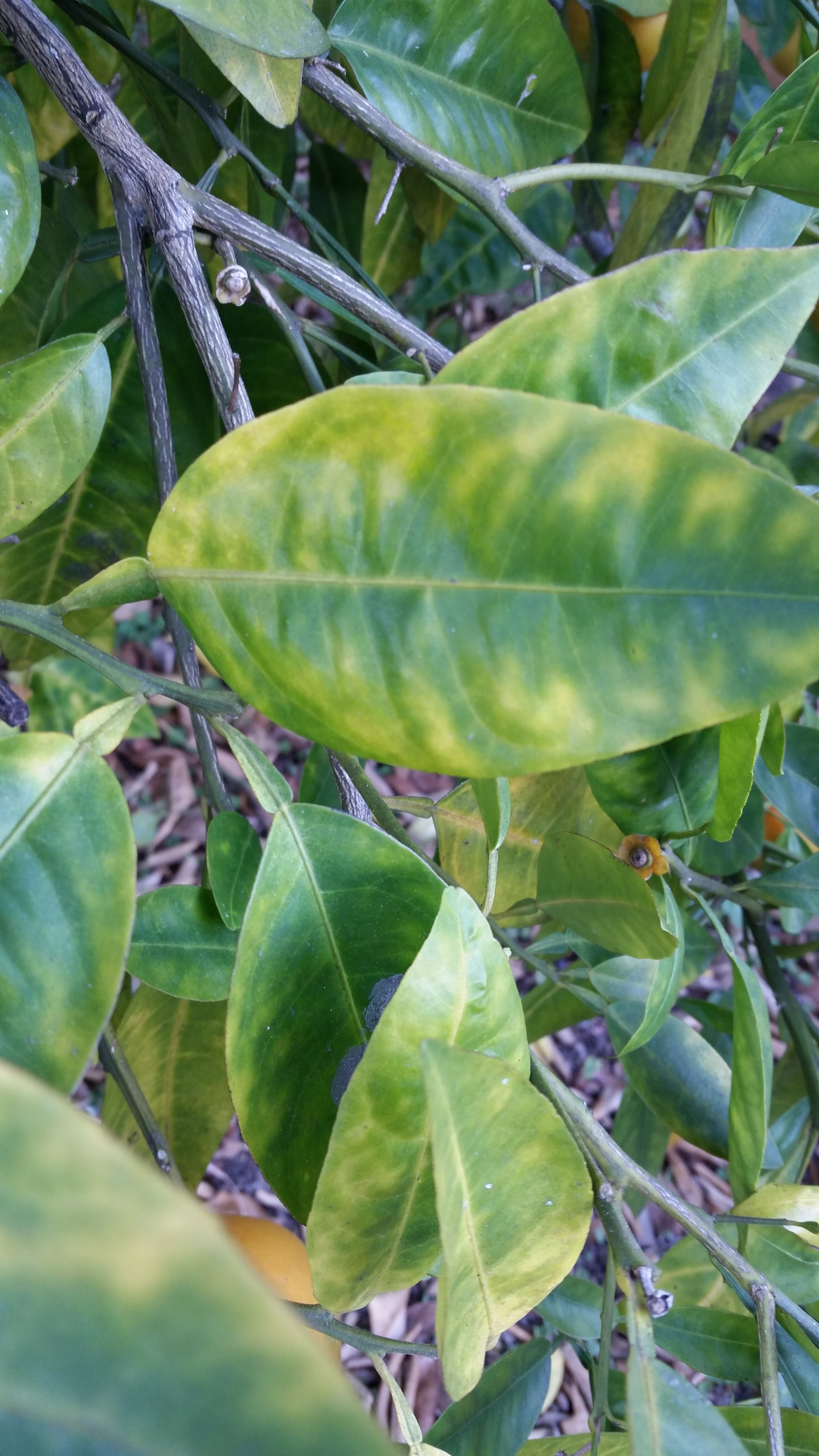
by Carrie Stevenson | Mar 2, 2017
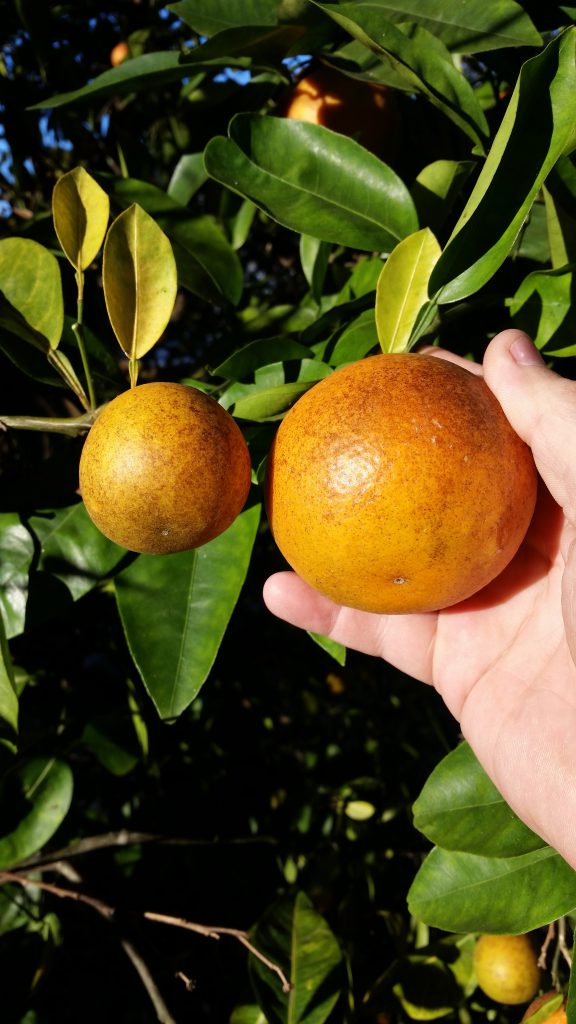
Small Fruit vs Normal
If we look at the big picture when it comes to invasive species, some of the smallest organisms on the planet should pop right into focus. A microscopic bacterium named Candidatus Liberibacter asiaticus, the cause of Citrus Greening (HLB), has devastated the citrus industry worldwide. This tiny creature lives and multiplies within the phloem tissue of susceptible plants. From the leaves to the roots, damage is caused by an interruption in the flow of food produced through photosynthesis. Infected trees show a significant reduction in root mass even before the canopy thins dramatically. The leaves eventually exhibit a blotchy, yellow mottle that usually looks different from the more symmetrical chlorotic pattern caused by soil nutrient deficiencies.
One of the primary vectors for the spread of HLB is an insect called the Asian citrus psyllid. These insects feed by sucking juices from the plant tissues and can then transfer bacteria from one tree to another. HLB has been spread through the use of infected bud wood during grafting operations also. One of the challenges with battling this invasive bacterium is that plants don’t generally show noticeable symptoms for perhaps 3 years or even longer. As you would guess, if the psyllids are present they will be spreading the disease during this time. Strategies to combat the impacts of this industry-crippling disease have involved spraying to reduce the psyllid population, actual tree removal and replacement with healthy trees, and cooperative efforts between growers in citrus producing areas. You can imagine that if you were trying to manage this issue and your neighbor grower was not, long-term effectiveness of your efforts would be much diminished. Production costs to fight citrus greening in Florida have increased by 107% over the past 10 years and 20% of the citrus producing land in the state has been abandoned for citrus.
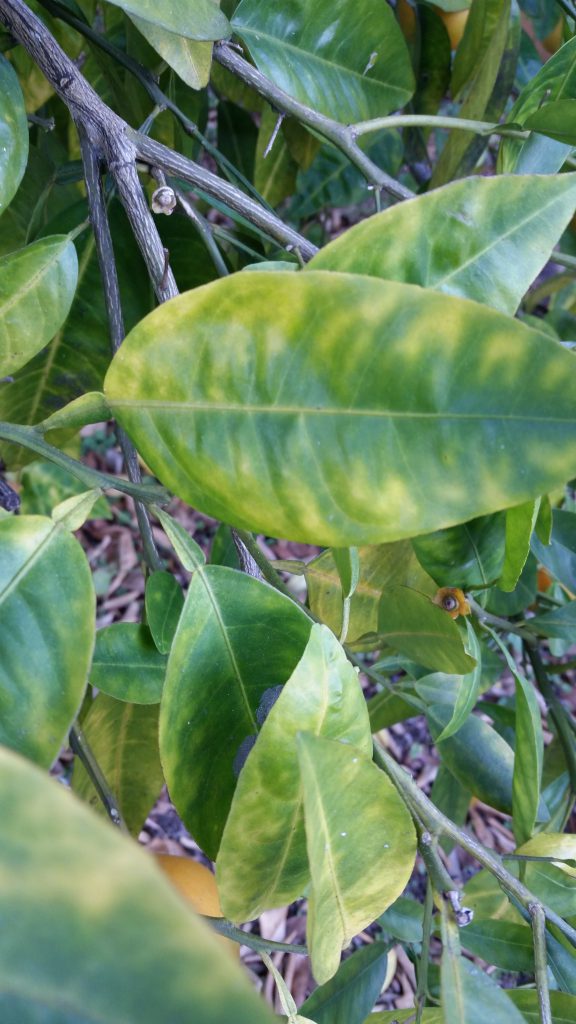
Classic blotchy mottle in Leaves
Many scientists and citrus lovers had hopes at one time that the Florida Panhandle would be protected by our cooler climate, but HLB has now been confirmed in more than one location in backyard trees in Franklin County. The presence of an established population of psyllids has yet to be determined, as there is a possibility infected trees were brought in.
A team of plant pathologists, entomologists, and horticulturists at the University of Florida’s centers in Quincy and Lake Alfred and extension agents in the panhandle are now considering this new finding of HLB to help devise the most effective management strategies to combat this tiny invader in North Florida. With no silver-bullet-cure in sight, cooperative efforts by those affected are the best management practice for all concerned. Vigilance is also important. If you want to learn more about HLB and other invasive species contact your local UF/IFAS Extension office.
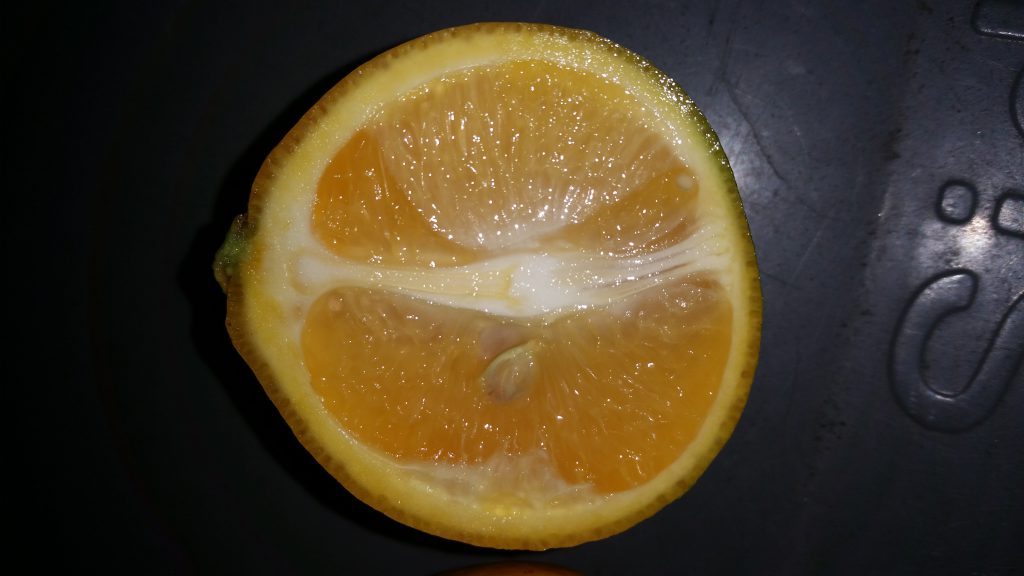
Asymmetrical Fruit
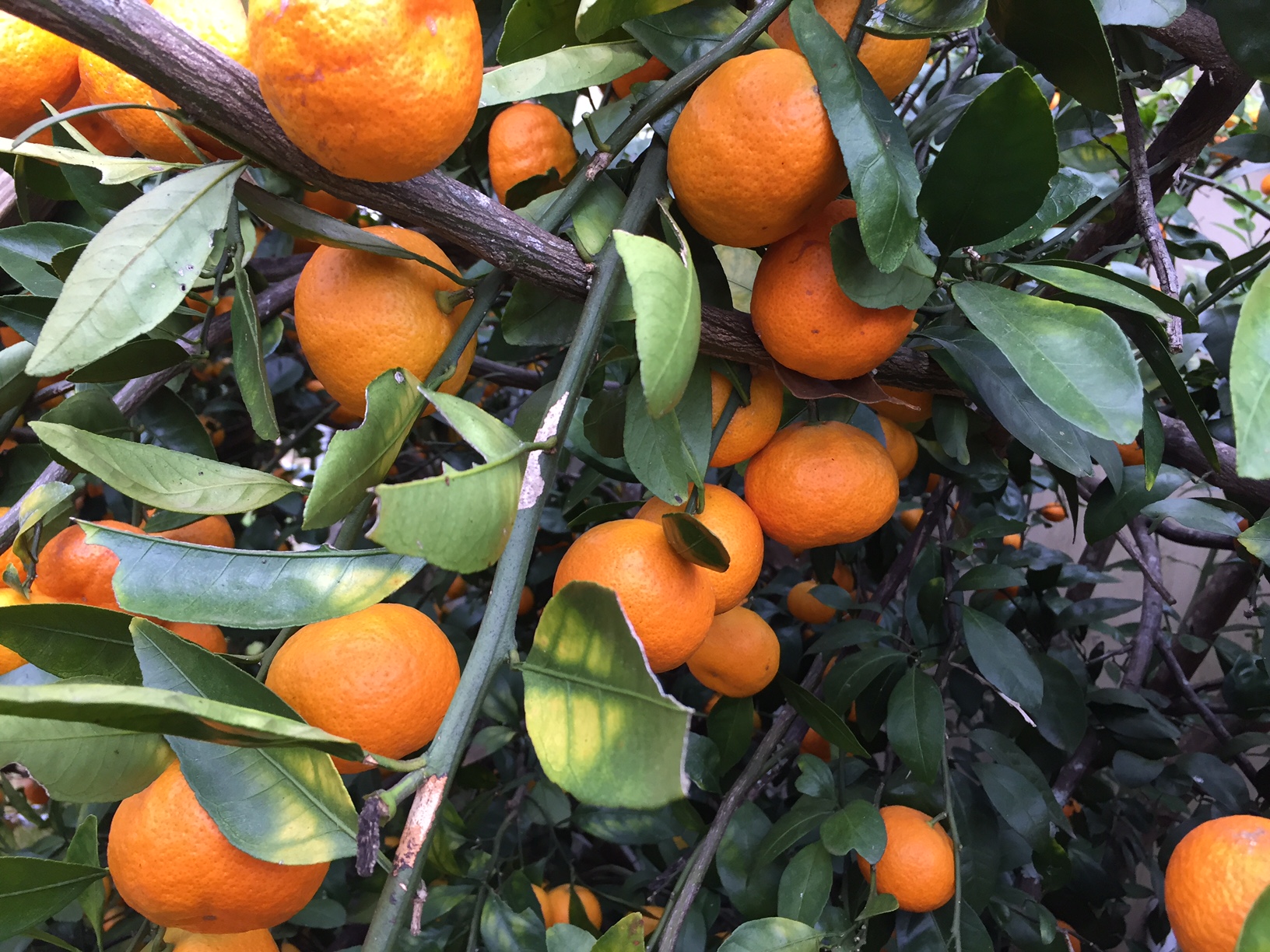
Typical nutrient deficiencies observed in leaf, on trees with heavy fruit load. Not related to Citrus Greening (HLB)
Article by: Erik Lovestrand, UF/IFAS Franklin County Extension Director/Florida Sea Grant Agent

by Matthew Orwat | Feb 14, 2017
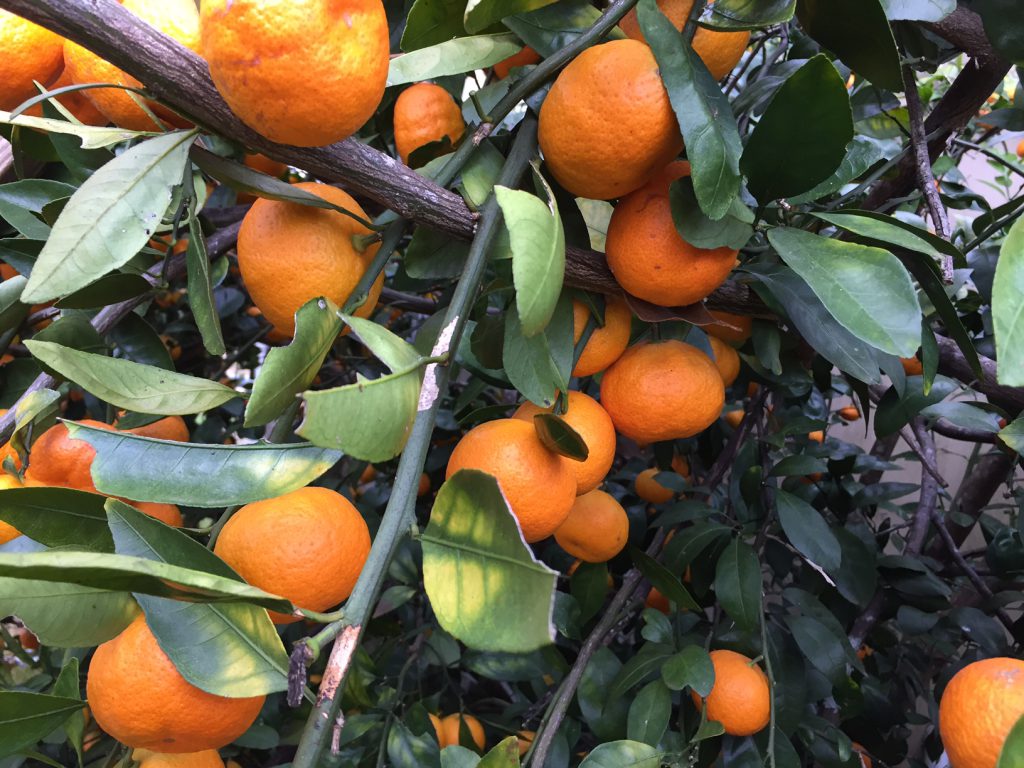 Dooryard citrus enthusiasts may be uncertain about late winter management of Satsuma and other citrus trees. Several questions that have come in to the Extension Office recently include:
Dooryard citrus enthusiasts may be uncertain about late winter management of Satsuma and other citrus trees. Several questions that have come in to the Extension Office recently include:
- Should I prune my trees?
- Why are the leaves yellow?
- How soon should I fertilize?
The focus of this article is to provide some answers to these common questions.
Should I prune my trees?
This is a complicated question that is best answered with “it depends…” Pruning is not necessary for citrus, as it is in many temperate fruits, to have excellent production quality and quantity. Citrus trees perform excellently with minimal pruning. The only pruning necessary for most citrus is removing crossing or rubbing branches while shaping young trees, removing dead wood, and pruning out suckers from the root-stock. Homeowners may choose to prune citrus trees to keep them small, but this will reduce potential yield, since bigger trees produce more fruit.
Often, maturing Satsuma trees produce long vertical branches. It is tempting to prune these off, since they make the tree look unbalanced. To maximize yield, allow these branches to weep with the heavy load of fruit until they touch the ground. This allows increased surface area for the tree, since the low areas around the trunk are not bare. Additionally, weeds are suppressed since the low branches shade out weed growth. The ground under the trees remains bare, thus allowing heat from the soil to radiate up during cold weather events. The extra branches around the trunk offer added protection to the bud union as well. If smaller trees are desired for ease of harvest, ‘flying dragon’ root-stock offers dwarfing benefits, so that the mature scion cultivar size will only grow to 8-10 feet tall.
Heavy fruit loads were produced in many home gardens throughout Northwest Florida last year. When fruiting is heavy, citrus trees translocate nitrogen and other nutrients from older leaves to newer growth and fruit. Therefore, temporary yellowing may occur and last until trees resume growing in the spring. Remember, never fertilize after early September, since fertilizing this late in the year can reduce fruit quality and increase potential for cold injury. If a deficiency, as in the photo above persists through spring, consider a soil test, or consult a citrus production publication to determine if additional fertilizer should be added to your fertilizer program.
How soon should you fertilize?
Although most Florida citrus publications recommend fertilizing citrus in February, they don’t take into account the potential for late frost in the Panhandle. Thus it makes more sense to wait until mid-March for the first fertilizer application in this region. Citrus trees don’t require a fertilizer with a high percentage of nitrogen, so it is best for fruit quality if an analysis of around 8-8-8 with micro-nutrients is used. Fertilizer should be applied in the drip-line of the tree, not around the trunk. The drip-line of a mature tree is generally considered to extend one foot from the trunk out to one foot from the edge of the furthest branch tip from the trunk. For fertilizer quantity recommendation see the chart below.
Through awareness of the unique managements techniques inherent to dooryard citrus production in the Panhandle, home gardeners are offered an opportunity to provide their friends and family with a substantial portion of their annual citrus !
For more information on this topic please use the following link to the UF/IFAS Publication:
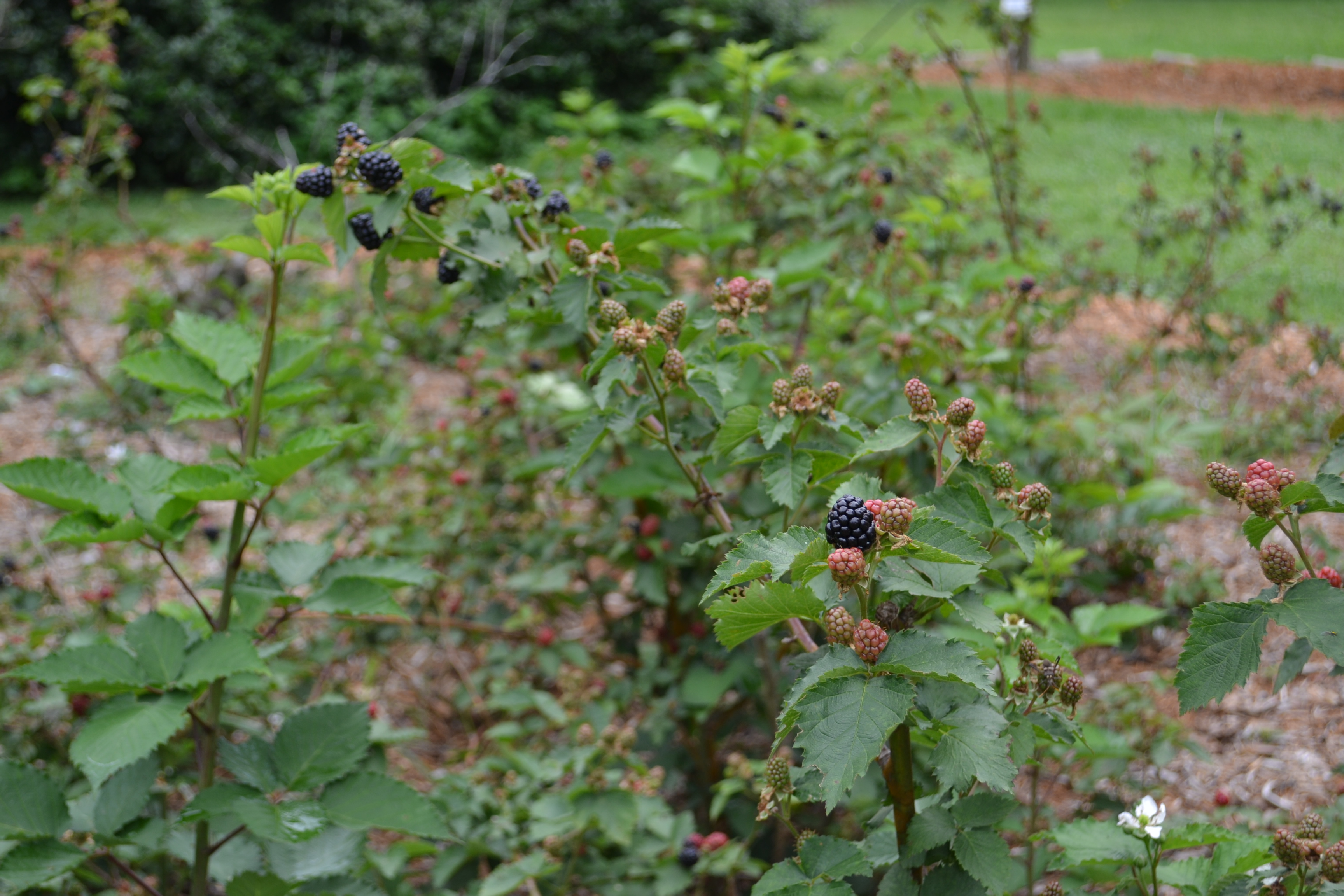
by Beth Bolles | Feb 14, 2017

Arapaho blackberry has chill requirements that match those received in our area. Photo by Beth Bolles, UF IFAS Extension
Many of us are enjoying warmer temperatures this winter, but many deciduous fruit crops really need cold temperatures in order to break dormancy for the year. In areas that experience cold temperatures, plants have evolved the ability to survive by slowing growth and protecting sensitive tissues by going dormant. In order to break out of dormancy and begin growth again, plants experience an amount of chill hours (temps between 32 and 45 degrees F) that is suitable for specific areas. In our area, we normally range between 400 and 600 chills hours.
If we choose a fruit plant whose chill requirements match the amount of chill in our area, the plant will generally resume growth when it is safe for buds and tender tissues to develop. If we choose a plant with chill requirements higher than the amount our area receives, then the plant is not signaled to break dormancy and we end up with very sparse growth and no fruit.
So far in the winter of 2016-17, some areas have not received ‘normal’ amounts of chilling temperatures. Common fruit like apple, peach, some blueberries, and certain selections of blackberries may be affected by this by not breaking out of dormancy. This can impact your flower and fruit formation. For commercial growers, it can impact the amount of fruit available and even fruit prices at markets.
Since fruit trees are an investment of time and money, these are not plants that can be easily replanted to match chill hours with changing weather patterns. Perhaps planting fruit crops with a range of chill hours required might be beneficial Your future decisions to grow fruit trees may include crops that don’t rely as much on chill hours to be successful. For more information, please consult the Dooryard Fruit Varieties guide from UF / IFAS Extension.














